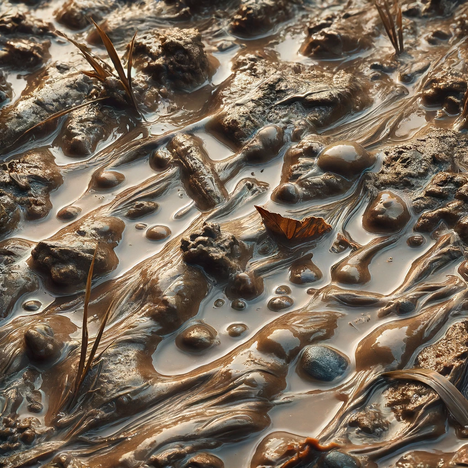Mud

Mud - that squishy mixture of water and soil found after a rainstorm or in wetlands - has a magical attraction for many dogs. The idea of a dog jumping through puddles and frolicking in the mud with exuberant joy may be an image of unadulterated happiness and freedom. But this seemingly harmless fun also carries risks that should not be overlooked. In this article, we take a deep dive into the world of mud to understand what it is, what benefits it can have for dogs and what potential dangers it poses.
What is mud?
Mud is formed when water and soil mix to form a soft, malleable mass. This natural phenomenon is often found in areas with high humidity, such as riverbanks, forests after rainfall or urban areas after flooding. Mud can consist of various minerals, organic matter and microorganisms, depending on its geographical location and the surrounding environmental conditions.
Benefits of mud for dogs
Natural play and discovery
- Stimulation: Mud provides an excellent sensory experience for dogs, encouraging curiosity and supporting natural behaviors such as digging and exploration.
- Exercise: Frolicking in mud can be a good source of physical exercise, helping to maintain a healthy cardiovascular system and strengthen muscles.
Mental well-being
- Stress relief: Interacting with mud can be a form of stress relief for dogs, similar to the effects of relaxing activities in humans.
- Happiness: It is undeniable that many dogs simply enjoy playing in the mud, which contributes to an increased sense of happiness.
Disadvantages and risks of mud for dogs
Health risks
- Parasites and bacteria: Mud can be a breeding ground for parasites, bacteria and viruses that can cause diseases such as leptospirosis or parasitic infestations.
- Toxic substances: In urban or industrial areas, mud can contain pollutants such as pesticides, heavy metals and other toxic chemicals that are dangerous to dogs.
Grooming and hygiene
- Coat and skin problems: Frequent play in mud can cause skin irritation, especially in dogs with sensitive skin. Mud drying in the coat can also lead to matting, which can be difficult to remove.
- Additional grooming effort: Dogs that play in mud often require extensive cleaning baths, which increases the grooming effort for the owner.
Mud offers a fascinating mix of benefits and risks for dogs. While playing in the mud can be a source of enjoyment and important physical and mental stimulation, it is essential to consider the potential health hazards and the additional maintenance required. As responsible pet owners, it's important to find a balance: Allow your dog to have fun in the mud, but be mindful of your animal companion's cleanliness and health. By choosing safe places to play, regular health checks and appropriate hygiene measures after muddy fun, you can ensure that your dog can enjoy the pleasures of mud without risking unwanted consequences.
If you notice any signs of hypersensitivity or poisoning in your dog, you should see your vet immediately. We are not a substitute for a vet, but we try to be as accurate as possible. Every dog reacts differently and we recommend you get a second opinion or consult your vet if in doubt.
Stay healthy and take good care of your four-legged friend!😊